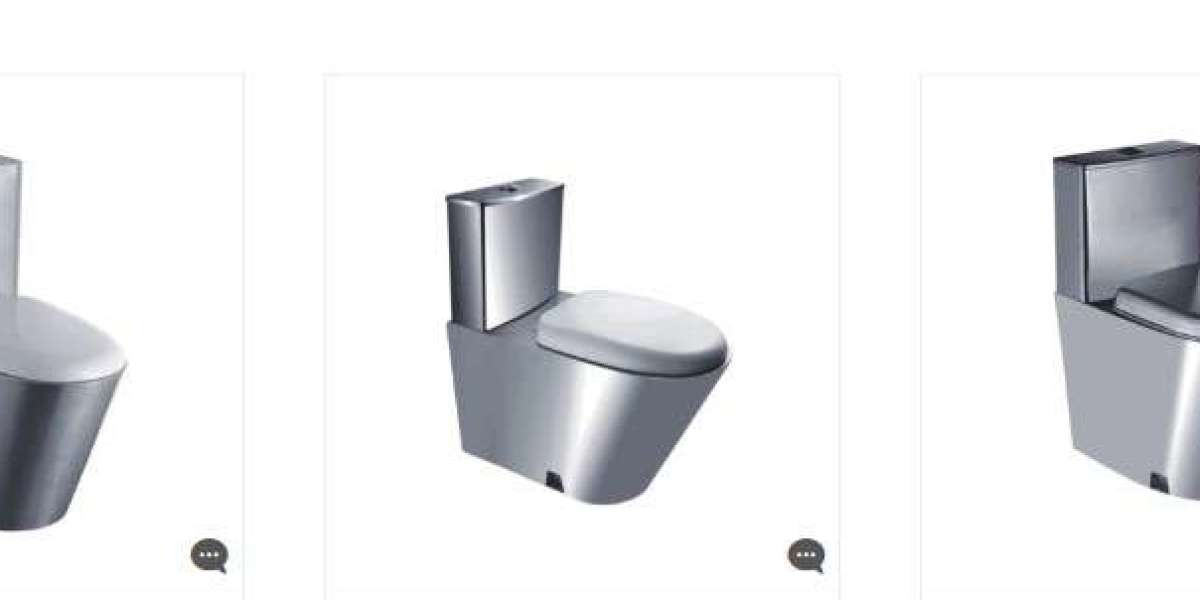Vandal-Resistant and Hygienic: Stainless Steel Combination Toilets Explained
When it comes to high-traffic facilities—such as prisons, hospitals, schools, and public restrooms—durability and hygiene are top priorities. Traditional porcelain toilets, while functional, often fail to withstand the rigors of constant use, vandalism, and strict sanitation standards. This is where the Stainless Steel Combination Toilet stands out as a superior solution.
Built to endure extreme conditions, prevent damage, and maintain impeccable hygiene, stainless steel combination toilets are becoming the go-to choice for architects, contractors, and facility managers. In this comprehensive guide, we’ll explore everything you need to know about these robust fixtures—what they are, why they’re used, their benefits, design features, and how to install and maintain them properly.
What Is a Stainless Steel Combination Toilet?
A Stainless Steel Combination Toilet is a single integrated unit that typically includes a toilet bowl, sink, and sometimes additional features such as a water bubbler or toilet paper holder—all fabricated from high-grade stainless steel. This design is most commonly used in environments where vandal resistance, hygiene, and space efficiency are essential.
Unlike traditional fixtures that use separate ceramic toilets and sinks, this combination unit merges all essential bathroom functions into one compact, solid piece. The entire structure is welded and polished to eliminate seams, joints, or crevices that could harbor bacteria or be exploited for tampering.
These units are often found in:
Correctional facilities and detention centers
Hospitals and psychiatric institutions
Public restrooms and transportation hubs
Military and industrial settings
Why Stainless Steel? The Science Behind the Strength
The primary reason stainless steel is chosen for these applications lies in its material properties. Stainless steel—particularly grades such as 304 or 316—is known for its:
Corrosion Resistance: Stainless steel resists rust and staining, even in wet or humid environments.
Strength and Durability: It can withstand significant physical impact without cracking or breaking, unlike porcelain or plastic.
Hygienic Surface: The smooth, non-porous finish discourages bacterial growth and makes cleaning effortless.
Fire and Heat Resistance: Stainless steel can tolerate high temperatures without deforming or releasing harmful substances.
Sustainability: It is 100% recyclable, making it an eco-friendly choice for environmentally conscious projects.
When these attributes are combined in a Stainless Steel Combination Toilet, the result is a fixture that offers unparalleled longevity, hygiene, and safety.
Key Features of a Stainless Steel Combination Toilet
A stainless steel combination toilet is engineered for performance and practicality. Some of its defining features include:
1. Vandal-Resistant Construction
The unit’s seamless design prevents tampering, prying, or dismantling. Heavy-duty anchoring systems and concealed plumbing ensure the toilet remains secure even in high-risk environments.
2. Integrated Design
With both a sink and toilet incorporated into one structure, the combination unit optimizes space and simplifies installation. This makes it ideal for compact areas or shared facilities.
3. Anti-Ligature Safety Features
In correctional or psychiatric settings, anti-ligature designs eliminate sharp edges and potential points where objects could be tied, enhancing safety and reducing self-harm risks.
4. Hygienic Finish
The polished stainless steel surface resists bacteria, stains, and odors. It can be easily disinfected using standard cleaning solutions without risk of damage.
5. Water-Saving Technology
Many modern combination toilets come with low-flow flush mechanisms and metered faucets, promoting sustainability and cost efficiency.
6. Customizable Options
Manufacturers often offer custom configurations—such as right- or left-hand sink orientation, ADA-compliant designs, and integrated soap dispensers—to meet specific facility needs.
Benefits of Installing a Stainless Steel Combination Toilet
1. Unmatched Durability
These units are built to last decades. Their solid construction resists vandalism, impact, and wear, reducing maintenance costs over time.
2. Enhanced Hygiene
Stainless steel’s non-porous surface prevents bacteria and mold buildup, a common issue with ceramic and plastic fixtures. This makes it ideal for environments where cleanliness is paramount.
3. Security and Safety
In detention centers or high-risk facilities, the anti-ligature and tamper-proof design of a Stainless Steel Combination Toilet ensures maximum safety for users and staff alike.
4. Space Efficiency
By combining a sink and toilet, these fixtures minimize the required footprint—perfect for compact restrooms or cells where every inch matters.
5. Easy Maintenance
Cleaning and maintaining a stainless steel unit is straightforward. A quick wipe with disinfectant keeps it sanitary and shining without the need for specialized products.
6. Aesthetic Appeal
Beyond utility, stainless steel brings a sleek, modern appearance that aligns with contemporary architectural designs.
Where Stainless Steel Combination Toilets Are Used
These fixtures serve a variety of purposes across different industries:
Correctional Facilities: Designed to resist tampering and damage.
Healthcare Environments: Promotes hygiene and easy cleaning in patient areas.
Public Restrooms: Ideal for high-traffic zones prone to vandalism.
Transportation Hubs: Durable enough for airports, train stations, and rest stops.
Industrial Facilities: Withstands harsh cleaning agents and constant use.
Each environment benefits uniquely from the combination of durability, cleanliness, and safety that a stainless steel combination toilet provides.
Step-by-Step Installation Guide
Installing a Stainless Steel Combination Toilet requires precision and attention to plumbing and structural details. Below is a simplified step-by-step process to ensure proper installation:
Step 1: Prepare the Area
Ensure that the installation wall or floor can support the unit’s weight.
Verify that water supply and waste lines are positioned correctly.
Step 2: Set Mounting Points
Use manufacturer-provided templates to mark anchor locations.
Drill holes and insert appropriate anchors or mounting hardware.
Step 3: Position the Unit
Carefully lift and align the combination toilet with the marked points.
Ensure all connections—drain, water supply, and waste outlets—align properly.
Step 4: Connect Plumbing
Securely attach water supply lines and waste pipes using flexible connectors or flanges.
Test connections for leaks before sealing.
Step 5: Secure the Fixture
Tighten mounting bolts and conceal them with tamper-proof covers.
Apply silicone sealant along the base for additional water resistance.
Step 6: Final Testing
Run water through the sink and flush the toilet to confirm proper operation.
Check for leaks or drips around all connections.
Once these steps are complete, the stainless steel combination toilet is ready for use—strong, sanitary, and secure.
Cleaning and Maintenance Tips
Maintaining a Stainless Steel Combination Toilet is simple, but following best practices ensures longevity and appearance:
Daily Cleaning: Wipe surfaces with mild soap and warm water.
Disinfect Regularly: Use non-abrasive disinfectants approved for stainless steel surfaces.
Avoid Harsh Chemicals: Steer clear of bleach or chlorine-based products that can corrode metal over time.
Polish Periodically: Use stainless steel polish to restore shine and prevent water spotting.
Inspect Sealants: Check joints and silicone seals periodically to prevent leaks.
With proper maintenance, the unit can remain functional and visually appealing for decades.
The Future of Public and Institutional Restroom Design
As hygiene and safety standards evolve, Stainless Steel Combination Toilets are becoming an industry benchmark. Modern designs now incorporate touchless flushing systems, sensor-activated faucets, and eco-efficient water controls—reducing both environmental impact and human contact.
Furthermore, stainless steel’s recyclability aligns perfectly with sustainable building initiatives such as LEED certification, making it a responsible choice for eco-conscious facilities.
Architects and planners are increasingly integrating these combination units into new projects—not just for prisons or hospitals, but also for airports, stadiums, and commercial complexes—where hygiene and vandal resistance are non-negotiable.
Conclusion
A Stainless Steel Combination Toilet represents the perfect blend of durability, safety, hygiene, and functionality. Whether installed in a correctional institution, healthcare facility, or high-traffic public restroom, it delivers long-term performance and reliability that traditional fixtures simply cannot match.
From its vandal-resistant construction and seamless design to its hygienic surface and low maintenance requirements, this modern sanitary solution offers lasting value and peace of mind. As public spaces evolve to prioritize cleanliness and sustainability, the stainless steel combination toilet will remain a cornerstone of intelligent, future-proof restroom design.













